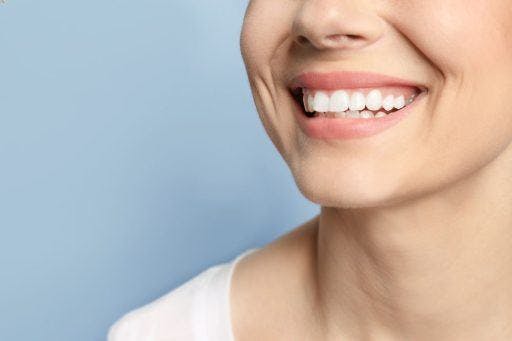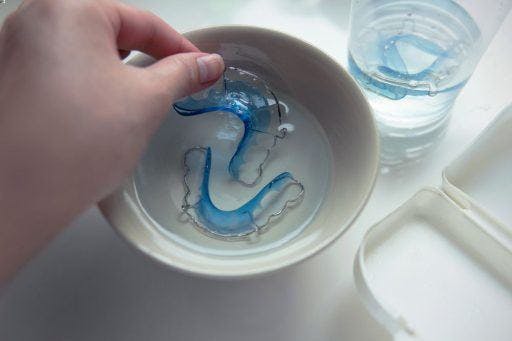So, you’ve completed ClearCorrect aligner therapy – what’s next? Most patients will need to wear teeth retainers immediately after to maintain their new smile. They’re an extra precaution against relapse from factors like ageing. The type of retainers, duration of treatment, and other considerations vary.
As always, it’s best to consult with your treating dentist to determine the ideal plan for your situation. But first, learn how retainers help, what options are available, and answers to common maintenance questions.
What are teeth retainers?
Orthodontic retainers are devices designed to retain your teeth’s new position after a dental straightening treatment. They’re usually composed of plastic or metal and, just like braces and aligners, are made custom.
Retainers help stabilise your teeth in their new positions. How long you must wear them depends on your dental needs and orthodontist’s recommendations. However, patient compliance is a major factor in their effectiveness.
According to a study in Children , an international journal on children’s health, many dental practitioners also recommend reusing retainers throughout your lifetime as teeth continue to shift due to many factors, including age or habits.
The importance of wearing retainers after aligners

Before jumping into this new phase of your oral care journey, it helps to know what retainers are for. As their name suggests, these custom orthodontic devices retain the teeth’s new alignment. Here’s how they can help you:
- They safeguard against post-treatment shifting and help ensure your investment won’t go to waste.
- Retainers also provide stability, so the teeth and surrounding tissues can more easily adapt to their corrected positions. As the Australian Society of Orthodontists (ASO) explains, “it takes time for a mouth to ‘learn’ the new positioning of their teeth once braces are removed.”
- Retainers enable the adaptation process while the supportive structures adjust.
- Retainers exert gentle, consistent pressure on the dentition, similar to aligners or braces.
The main differences between retainers and aligners lie in the treatment approach and duration. ClearCorrect aligners and similar devices move teeth to their ideal position, while retainers keep them in place once aligned. On average, aligner therapy can last anywhere from six months to a few years. Meanwhile, retainers may need to be worn for much longer – in some cases, forever.
Main types of dental retainers

There are two general types of retainers: 1) removable, and 2) permanent. You have multiple options within each category, depending on your needs. Here’s a brief overview.
Removable
Removable retainers can be incredibly convenient, especially if you’re diligent about proper storage and wear time. You can take them out during mealtimes, cleaning, and risky activities, like sports.
Examples include Hawley retainers, which consist of a thin metal wire and a custom-fitted, moulded acrylic base. The wire wraps around the front of the teeth for support, while its base sits against the roof of the mouth or the tongue side of the lower teeth.
There are also clear retainers, which look strikingly like clear aligners. They have the same discreet, barely visible appearance. Unlike wired retainers, they fully cover the teeth, including chewing surfaces. They may also be easier to acquire if you’ve used ClearCorrect as your dentist can use the intra-oral scan from the beginning of your treatment.
Permanent
Permanent retainers are also known as fixed, lingual, or bonded retainers. They stay in place with dental adhesive, so you never have to worry about losing them. They consist of wires that adhere to the backs of the teeth, preventing relapses through continuous support. They’re also invisible from the front.
Professor Dr James Mah, Interim Dean of the School of Dental Medicine at the University of Nevada, Las Vegas and former Chief Technology Officer of ClearCorrect (a Straumann Group brand), recommends this option for patients who desire more effortless maintenance (no need to keep track of them!). He also encourages their use for those with significant relapse factors, like generalised spacing, tongue thrusting, and deep bites.
5 tips for living with retainers
Just like braces and aligners, retainers require getting used to. If you’re coming from aligners, the adjustment may be minimal as both devices are detachable. Here are some tips to ensure you comply with your dentist’s recommendation and maintain those straight pearly whites.
1. Bring your retainer case with you.
Ideally, you should wear your teeth retainers as much as possible, but you may need to take them out several times a day, such as when eating, brushing and flossing, and during high-contact activities like sports.
Make sure you have your retainer case handy during these moments. Your retainers must not only be accessible but also sanitary.
2. Get more retainer cases and plant them everywhere.
Are you the type of person to lose things? Great job on the self-awareness! Try to have spare retainer cases around in case you lose one. You can even place some in areas you’re always in, such as the bathroom, bedroom, or office.
3. Clean your retainers regularly.
Retainers go inside your mouth, so hygiene is of utmost importance. Sanitise your retainers as instructed by your orthodontist. Don’t forget to clean the case, too. Remove any lingering dirt or debris before putting your retainers back on.
4. Develop a routine for your retainers.
Building a routine with your retainer can ensure consistent use, maintain good oral hygiene, and keep your retainer in great condition. For example, train yourself to put your retainers in a case before meals. Remind yourself to rinse them before slipping them back in your mouth. Soon, this process will become muscle memory.
5. Have spare retainers.
Picture this – you are at a restaurant and realise you left your case. You carefully tuck your retainers in some tissue before tucking into the food. A diligent waitress arrives and clears the trash from the table, including the napkin containing your precious dental appliance.
Since retainers are custom-made, you may need to wait a few weeks to get a new set, causing you to lose precious treatment time. Always ask your orthodontist for spare retainers in case of emergencies.
Teeth retainers: Frequently asked questions

Now that you know more about retainers and how they fit into your alignment journey, you may have a few follow-up questions. These answers should provide more clarity and ease dental anxieties. For more complex concerns, your treating dentist will know best.
1. How long do you wear retainers after ClearCorrect?
Are you wondering, “Do I need to wear retainers forever?” According to Dr Mah, “One common recommendation is full-time wear for about 12 months and night-time wear in the following years.” But he emphasises that duration can differ from patient to patient.
Those with mild to moderate teeth misalignment may require less time. Meanwhile, those with significant relapse factors may need to keep their retainers on for as long as they have natural teeth to maintain.
2. How do you care for your retainers?
Since retainers live in your mouth, they encounter the same bacteria and buildup as your teeth, gums, and tongue. Keep removable retainers hygienic and functional by rinsing them off after every meal and thoroughly cleaning them daily. Gargle with water before popping your retainers back in.
The ASO cautions against toothpaste for cleaning as it can be too abrasive for the material. Instead, use hand soap and a soft brush. You can also soak them in an antibacterial appliance solution to keep them fresh. Remember to store them in their proper container when not in use. Lastly, avoid soaking them in hot water since high temperatures can warp the material.
As for fixed retainers, you can clean the wires when you brush your teeth. Flossing becomes even more critical here since food particles can get stuck in the nooks and crannies of the device. So, don’t skip that step! Ask your treating dentist for tips to make the process easier. They may recommend using interdental brushes that clean hard-to-reach spaces between teeth. Also, avoid chewing anything too hard so as not to risk breakage.
3. Do you still need to see your dentist for checkups?
Yes, you’ll need to visit your dentist for regular checks. Aim to see them every six months. This will help them determine if your retainers are doing their job effectively or if the device needs refitting. Your dentist can also assess if your teeth are still in their correct position. If not, they may need to adjust your retainers.
4. What do you do when you break or bend your retainers?
The first thing you need to do is to remove the broken retainers from your mouth. Cracks or fractures could hurt you. Do not attempt to fix them either. Your retainers have been moulded to follow the shape of your teeth. The slightest shift in angle could be counterproductive.
Ideally, you should always have spare retainers handy in case of breakage or loss. If you don’t have any, visit your orthodontist urgently and let them assess the damage. Let them decide if you need a new order or not.
Are you still wondering if teeth retainers are necessary after clear aligners? The short answer is yes. Your ClearCorrect aligners may be effective in straightening your teeth – thanks to its tri–layer ClearQuartz material and unscalloped trimline. However, you’re going to need some post-treatment retainers to keep your smile that way.
After all the time, effort, and money you put into improving it, you should do what you can to maintain your new smile. Work with your dentist to determine the best post-aligner maintenance plan for you!
References:
Summers, J. (2021). Types of Retainers. ClearCorrect Help Center. Retrieved June 13, 2023.
Summers, J. (2022). Retainers and Retention. ClearCorrect Help Center. Retrieved June 13, 2023.



